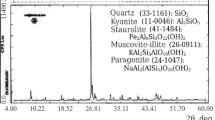Abstract
The diamond-bearing gravels found along South Africa's West Coast are being beneficiated by means of dense medium separation (DMS) to reclaim the alluvial diamonds. Granular ferrosilicon (Fe–Si) is used as the DMS material and at the end of each operation the Fe–Si is reclaimed from the process stream using a magnetic separator and is then recycled but losses of Fe–Si due to attrition, adhesion to the separation products, density changes and changes to the magnetic properties can occur. The gravel obtained from the mining operation is washed and screened before heavy mineral separation. The concentrate, tailings and Fe–Si samples were investigated by means of SEM and Mössbauer spectroscopy to determine where changes to the Fe–Si, or contamination could occur. The composition of the Fe–Si was determined to be Fe (76.1 at.%), Si (20.3 at.%), Mn (1.5 at.%), Al (1.5 at.%) and Cr (0.6 at.%) resulting in a more or less ordered DO3 phase with a calculated composition of Fe3Si for this Fe–Si, consistent with the Mössbauer results where two sextets with hyperfine magnetic fields of 18.6 T and 28.4 T were observed. After DMS, magnetite and ilmenite, the minerals found in the gravel, were still present in the concentrate. In the tailings virtually no magnetite or ilmenite was found and only a doublet, identified as an oxihydroxide, due to the abrasion of the Fe–Si, was found. After magnetic separation, to wash and clean the Fe–Si for re-use, it was found that magnetite and ilmenite were still present in the Fe–Si, which results in a change in density of the Fe–Si, resulting in a higher density and loss of valuable diamonds.
Similar content being viewed by others
References
Hammerbeck E. C. I. and Mehliss A. T. M., In: C. B. Coetzee, (eds), Ore Deposits of the Republic of South Africa, Handbook 7, Department of Mining and the Geological Survey of South Africa, The Government printer, Pretoria, South Africa, 1976, pp. 461.
http://www.debeersgroup.com and personal communication.
Waanders F. B. and Mans A., Hyperfine Interact. 148–149 (2003), 325–329.
Stearns M. B., Phys. Rev. 129(3) (1963), 1136–1144.
Nkosibomvu Z. L., Witcomb M. J., Cornish L. A. and Pollak H., Hyperfine Interact. 112(1–4) (1998), 261–265.
Stevens J. G., Khasanov A. M., Miller J. W., Pollak H. and Li Z. (eds.), Mössbauer Mineral Handbook, Mössbauer Effect Data Centre, University of North Carolina, Asheville, USA, 1998, p. 527.
Author information
Authors and Affiliations
Corresponding author
Rights and permissions
About this article
Cite this article
Waanders, F.B., Rabatho, J.P. Recovery of Heavy Minerals by Means of Ferrosilicon Dense Medium Separation Material. Hyperfine Interact 161, 55–60 (2005). https://doi.org/10.1007/s10751-005-9191-3
Published:
Issue Date:
DOI: https://doi.org/10.1007/s10751-005-9191-3




